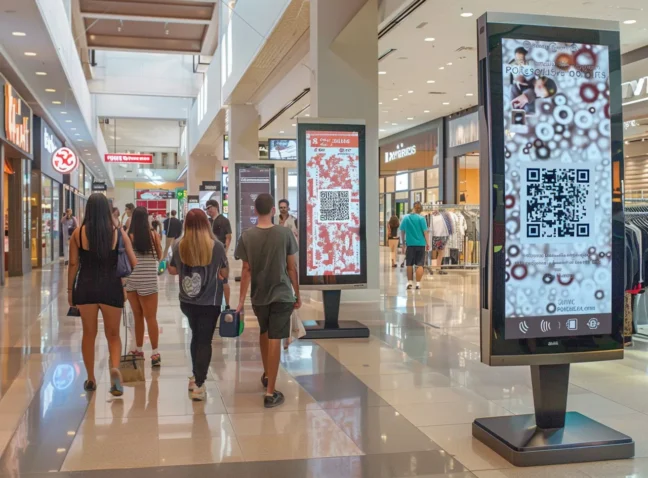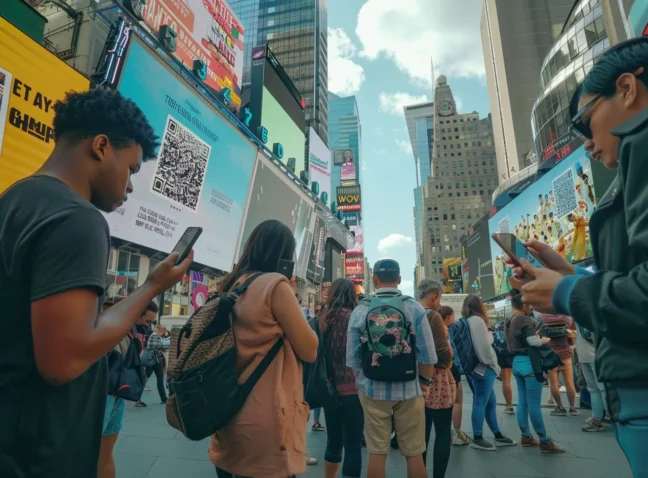QR codes come in a variety of different sizes; from the monumental ones you see on billboards, to the more bespoke QR codes included in clothing labels. There’s a size to fit any need. But just how small can a QR code be, while still being functional? An important question to answer, especially if you’re looking to generate your own QR codes.
Thankfully, My QR Code has all the answers you need. We’ll be going through the minimum size of a QR code for a number of use cases, so you’ll be able to maximize your space on promotional materials, business cards, and more. Plus, you’ll be able to test the minimum sizes of QR codes yourself with our handy QR code generator.
QR code minimum size: the facts
The QR code minimum size can be as little as 1 cm x 1 cm, corresponding to 10 mm x 10 mm, 0.4 inches x 0.4 inches, and 38 pixels x 38 pixels. But, creating an efficient code this small requires careful consideration of various factors:
- Scanning Distance – How far are you expecting users to be from the QR code? If they’re scanning a QR code on product packaging, the QR code can be much smaller, as they’re close to the object. But if you’re planning to add a QR code to a billboard, users will be further away, so the QR code will have to be bigger.
- Data Capacity – Smaller QR codes (like Micro QR codes) can only hold a limited amount of data compared to their larger counterparts. This is because data has to be encoded into a smaller space. So, if you’re looking to encode a large amount of data, you’ll need to opt for larger QR codes versions. Speaking of which…
- QR Code Versions – QR code versions relate to the number of data modules in a QR code, which store a QR codes’ readable data. Data modules are the black and white squares that make up the center of a QR code, and are stored both vertically and horizontally. There are 40 different versions, with version 1 containing 44 data modules, and version 40 containing a massive 344 data modules.
- Error Correction Level – The error correction level is data encoded into a QR code that still allows a QR code to be read, even if it becomes damaged. Error correction has 4 different levels, which restores data from 7% – 30% based on your needs. However, encoding error correction requires space, which could be a problem for smaller QR codes.
As you can see, there’s many technical factors in deciding what size QR code to use. One additional consideration to keep in mind is that smaller QR codes have limited data capacities. That means you’ll also need to decide what information you want to prioritize. While embedding links or tracking data into a small QR code won’t be a problem, you won’t be able to include huge text or PDF files.QR Code Scanning Distance
The scanning distance of a QR code is the optimal range at which the code can be captured and read by a scanning device. The QR code’s size and specific use case are just a few factors that impact this range.
Picture this: if you place a QR code on your restaurant table, your customers can easily scan it up close. But if you hang it up on the wall, your QR code needs to be larger to ensure users can scan it from further away.
QR Code Capacity
QR code capacity is the amount of data a QR code can store effectively. It largely depends on the QR code’s size and the error correction level. So, if you want to encode more information, you’ll need to make your code bigger.
For example, a big QR code can store up to 2,953 bytes of data, 7,089 numeric characters, 4,296 alphanumeric characters, or 1,817 Kanji symbols. Small ones, in turn, may have more limited storage.
Small ones in comparison, like version 1 QR codes, can only store a maximum of 152 bytes, 41 numeric characters, 25 alphanumeric characters, 17 binary, and 10 Kanji symbols.
Where Are the Smallest QR Codes Used?
You’ll often find the smallest QR codes in the computing industry, where they’re used on technical parts like computer chips, motherboards, and graphics cards. Generally, they’re used to store the technical specifications of the items in question, but are sometimes used for tracking purposes.
QR codes used for this purpose are often printed at 0.4 x 0.4 inches, or 1 cm x 1 cm. These often require specialized scanning equipment to be read effectively, and can’t be encoded with as much information.
Minimum Size of QR Codes for Various Purposes
QR codes are crucial for various purposes, with applications in printed materials, billboards, business cards, restaurant menus, and beyond. They’ve entered our daily lives and offered an effective way of sharing information.
But how small can these codes get while keeping their intended functionality? Let’s figure this out.
Minimum Size of a QR Code for Printing
The minimum size for printing ISO/IEC 18004-compliant QR codes is 1 cm x 1 cm, equivalent to 10 mm x 10 mm and 0.4 inches x 0.4 inches. These dimensions strike a balance between compactness and readability.
However, printing such small QR codes is not recommended. While some specialized scanning equipment may read those easily, smartphones may struggle to do so. That’s why making your QR code at least 2 cm x 2 cm (20 mm x 20 mm or 0.8 inches x 0.8 inches) is best.
Minimum Size of a QR Code for a Business Card
The QR code’s minimum size for a business card may be 2 x 2 cm, 20 x 20 mm, or 0.8 x 0.8 inches. It’s especially suitable for standard cards, usually 9 x 5 cm in size.
Yet, you can include bigger QR codes if your business card’s dimensions allow for it. Try incorporating a 2.5 cm x 2.5 cm (or 1 inch x 1 inch) code for better scannability and, ultimately, easier contact sharing.
Minimum Size of a QR Code for Billboards
The QR code’s minimum size for billboards varies following the billboard’s dimensions and scanning distance, but it’s typically 100 x 100 cm, 1,000 x 1,000 mm, or 39 x 39 inches for a 300 x 400 cm city street billboard.
If your billboard’s size and scanning distance are larger, a suitable QR code may be as much as 150 x 150 cm or 59 x 59 inches in size.
Minimum Size of a QR Code for a Restaurant Menu
The QR code’s smallest size for a restaurant menu is 2 x 2 cm, 20 x 20 mm, or 0.8 x 0.8 inches. These are the perfect dimensions for tabletop codes.
Reducing your digital menu QR code’s size isn’t advisable. Even when your customers scan from a close distance, their devices may not be able to read codes smaller than 2 x 2 cm.
Minimum Size of a Scannable QR Code on Different Devices
Most modern devices like smartphones and tablets can scan the QR codes at least 2 x 2 cm, 20 x 20 mm, or 0.8 x 0.8 inches in size. It’s possible owing to the built-in scanning features.
Yet, some older models may require larger QR code dimensions to read properly. Consider this before implementing such codes into your products and services.
Minimum Size Requirements for Different Types of QR Codes
Some QR codes can be as small as 1 x 1 cm, 10 x 10 mm, or 0.4 x 0.4 inches. The other versions may require larger dimensions to encode data correctly.
Let’s review the most common types of QR codes available and explore their minimum size requirements in detail.
Minimum Size Requirements for a Standard QR Code
The minimum size of a standard QR code is around 2 x 2 cm, 20 x 20 mm, or 0.8 x 0.8 inches. Such dimensions make this code suitable for various applications, from restaurant menus to business cards.
The minimum size requirements also depend on the type of standard QR code you use. Model 1, for example, can be as small as 21 x 21 modules, while Model 2 should consist of at least 25 x 25 modules.
Minimum Size Requirements for a Micro QR Code
The minimum size requirement for a micro QR code is 1 x 1 cm, which translates to 10 x 10 mm and 0.4 x 0.4 inches. Yet, it’s possible to make it even less than 1 square cm.
Since micro QR codes come in significantly smaller dimensions than standard ones, they often cannot be scanned by the typical built-in apps on Android and iOS devices. That’s why installing specialized apps for a successful scan may be necessary.
Speaking of the micro QR code dimensions, there are four versions: M1, M2, M3, and M4. Each consists of 11×11, 13×13, 15×15, and 17×17 modules, respectively.
Minimum Size Requirements for rMQR Codes
The smallest rMQR codes may be 0.18 x 1.1 cm, 1.8 x 11 mm, or about 0.07 x 0.43 inches in size. Such tiny solutions can store only up to twelve numeric and seven alphanumeric characters.
The rMQR code’s dimensions of 0.18 x 1.1 cm comprise seven modules arranged vertically and 43 modules arranged horizontally. This shape makes this solution perfect for placement in narrow spaces.
Minimum Size Requirements for SQRC Codes
The minimum size of SQRCs is the same as the standard ones: 2 x 2 cm, 20 x 20 mm, or 0.8 x 0.8 inches. They look just like traditional QR codes but are designed to store confidential information.
One of the main features of an SQRC is data reading restriction. It means that the code can be scanned and decoded only through a dedicated reader with a unique cryptographic key.
Minimum Size Requirements for Frame QR Codes
Frame QR codes’ minimum size requirements are similar to standard QR codes, namely 2 x 2 cm, 20 x 20 mm, or 0.8 x 0.8 inches. While they can be made smaller, it may hinder their readability.
Frame QR codes have a canvas field in the middle, which you can use to insert your company logo, images, or letters. That’s the primary reason not to reduce these codes in size.
What Is the Minimal Size of a QR Code, Including Surrounding Whitespace?
The minimum size of a QR code with surrounding whitespace is 2.3 x 2.3 cm, 23 x 23 mm, or around 0.9 x 0.9 inches. The whitespace, or a quiet zone, must take 15% of the overall code’s dimension.
Let’s now look at how different sizes of QR codes correlate with varying storage capacities and the required amount of whitespace. See the table below:
[Insert table]
If we measure whitespace in modules, it’s best to have at least a four-module quiet zone for standard QR codes and two modules for micro QR codes.
What Is a QR Code Quiet Zone?
A quiet zone, or whitespace, is a clear space that surrounds the QR code. It’s like a buffer that separates the code from surrounding elements and allows devices to identify and scan it accurately.
The quiet zone’s size is typically proportional to the QR code’s dimensions. The larger the QR code requires a bigger whitespace to remove visual clutter and make codes readable.
How to Calculate Whitespace Around a QR Code?
To calculate the size of a quiet zone, multiply the module size in cm, mm, or inches by four. For example, if your module size is 0.5 cm, the whitespace around the QR code would be 2 cm.
If you want to apply the formula mentioned above, it’s critical to calculate the module size first. The dimensions of each module depend on your printer resolution and the number of dots within each module.
Factors That Influence the QR Code Size
The QR code size depends on several factors: scanning distance, data capacity, error correction level, QR code version, and customization required. Each of them dictates the specific dimensions necessary for your use case.
Let’s now explore all these factors in greater detail.
Distance-to-Size Ratio for QR Codes
The standard distance-to-size ratio for QR codes is 10:1. This proportion means that the QR codes work best when the device scanning them is about ten times as far away as the width of the QR code itself.
Here’s a table that demonstrates the correlation between the scanning distance and the QR code size:
[ Insert table ]
Minimum Scanning Distance for QR Codes
Though it’s best to follow the distance-to-size ratio of 10:1, the minimum QR code scanning distance is less than 5 cm, 50 mm, or 1.97 inches. That’s the closest your device can get to read a QR code properly.
However, sticking to this minimum distance isn’t advisable. When your device is too close, it may struggle to capture the entire code. This, in turn, may lead to slower or less accurate scans.
How Does the Amount of Stored Data Influence a QR Code Size?
QR codes store data in modules and, following the data amount you aim to encode, you’ll require a different number of modules. Ultimately, you’ll get a larger or smaller QR code.
The QR code’s data capacity is determined by its version or model. According to ISO/IEC 18004, there are 40 versions of QR codes, with the smallest comprising 21 × 21 modules and the biggest consisting of 177 × 177. Additionally, this standard outlines four micro QR code dimensions, spanning from 11 × 11 to 17 × 17 modules.
The alphabet type influences the size of a QR code as well. Different QR code versions have varying capacities to store certain characters like kanji, numeric, and alphanumeric. For example, Version 1 can accommodate up to 10 kanji and 25 alphanumeric characters, while Version 25 can store a maximum of 784 kanji and 1,853 alphanumeric symbols.
How Does Error Correction Influence a QR Code Size?
Error correction levels help recover damaged or lost QR code information, yet they consume considerable space and make the overall size of the code larger. There are four distinct error correction levels:
- L (Low): Recovers up to 7% of data.
- M (Medium): Recovers up to 15% of data.
- Q (Quartile): Recovers up to 25% of data.
- H (High): Recovers up to 30% of data.
When creating a QR code, consider the error correction in combination with the code version. It’s critical because the size of the QR code and its data capacity directly depend on this connection.
Do Customization Options Influence the QR Code Size?
The logo, dot type, square type, and shape are some available customization options that impact the QR code’s size. If you need to reduce your code’s dimensions, leaving only the most necessary elements is best.
For example, you can use your brand’s colors instead of large logos to minimize the QR code size. Or you may want to try basic patterns and shapes instead of complex ones.
QR Code Definition
A QR code, short for quick-response code, is a two-dimensional barcode developed by the Japanese company Denso Wave in 1994. It comprises black squares placed on a white square grid and allows for encoding information.
The distance of QR code scanning and the data capacity of a QR code are other essential concepts in QR code technology. Let’s explore them more thoroughly.
What Are Recommended and Maximum Scanning Distances for a QR Code?
The recommended scanning distance for a QR code follows the 10:1 distance-to-size ratio. For example, if your QR code is 10 × 10 cm, it’s best to scan it from 100 cm.
However, there’s no specific limit for the maximum scanning distance. It’s because it hugely varies based on the scanning device resolution, QR code size, and its overall quality. If you leverage the largest possible code of 170 × 170 modules, it can be read from several meters away.
What Is the Smallest and Biggest Amount of Data a QR Code Can Store?
The smallest amount of data a QR code can store is 17 numerics, 10 alphanumerics, and 4 kanji characters, as well as 7 bytes. The tiniest micro QR code (M1) can only accommodate five numeric symbols.
The biggest amount of data a QR code can hold is 7,089 numeric characters, 4,296 alphanumeric characters, 2,953 bytes, and 1,817 Kanji symbols. It’s possible in Version 40 with an L error correction level.
Let’s also look at the several QR code versions and their data capacities:
[Insert Table]
The above data is based on the ISO/IEC 18004 standard.
What Are the Minimum and Maximum Sizes of QR Codes?
The minimum size of a QR code is 21 × 21 modules, which can be as little as 1 x 1 cm, 10 x 10 mm, or 0.4 x 0.4 inches. Micro QR codes are even smaller and can consist of only 11 × 11 modules.
The biggest QR code, which is Version 40, is as extensive as 177 × 177 modules. Its dimensions can reach several square meters, and this code holds the largest amount of data.
Are the Smallest QR Codes Less Secure?
The smallest QR codes aren’t less secure than standard ones. Their size only influences their capacity to store data, where tiny codes can accommodate less information compared to larger ones.
Security issues with QR codes are usually about the content they encode, not their physical size. If the code links you to a malicious website, that’s when you risk exposing sensitive information. In this and similar cases, the code’s size doesn’t matter.
Where Are the Smallest QR Codes Used?
The smallest, or micro QR codes are used in scenarios with limited space, like product tags and business cards. Let’s review these and other use cases in greater detail.
- Product tags: Used to store SKUs, prices, or product details.
- Business cards: Used to share contact information.
- Printed media: Used in print advertising, magazines, or posters.
On top of that, small QR codes are common in printed circuit boards. They’re used to mark the PCB parts and store essential technical specs.
How to Make Sure That My Small QR Code Is Readable?
To ensure that your small QR code is readable, pay attention to code version, error correction, and other factors. Consider the following tips:
- Select a suitable error correction level,
- Choose the appropriate QR code version,
- Optimize the encoded QR code content,
- Avoid cluttered design solutions,
- Ensure top printing quality.
Besides that, you can check your QR code’s readability by trying to scan it from various devices. It’ll also help to scan the code from different angles and distances.
Innovative Uses of Tiny QR Codes in Marketing and Retail
Tiny QR codes are prevalent in retail and marketing: they provide product descriptions, offer pocket-size promotions, and more. Here are even more uses of these solutions:
- Printed ads: Marketers use QR codes in small flyers or product tags.
- Product info: Retailers store serial numbers and product specs through QR codes.
- Contactless payments: Retailers leverage tiny QR codes to offer quick and secure payments.
Small QR codes can also be used for inventory management purposes. These solutions help monitor their supply chain by quickly accessing product manufacturing dates, serial numbers, or technical specs.
Can I Resize the QR Code Once Generated?
You can resize the QR code after generating it. Yet, when trying to make the code bigger or smaller, consider the aspect ratio to ensure proper functionality.
The aspect ratio is 1:1 in all QR codes except for rectangular ones. Scale your QR code up and down following these proportions. If you’re using a code’s digital version on your website or app, you can simply zoom in or zoom out to resize it.
Minimum Size for Dynamic and Static QR Codes
The minimum recommended size for dynamic QR codes is 2 x 2 cm, 20 x 20 mm, or 0.8 x 0.8 inches. These kinds of codes are available in our QR code generator, My QR Code.
For static codes, it’s preferable to leverage larger dimensions. Those can be around 3 x 3 cm, 30 x 30 mm, or 1.2 x 1.2 inches.
How to Generate a Small QR Code?
To create a small QR code, use the QR code generator tool by MyQRCode. Here are the essential steps:
- Open MyQRCode and click Create QR code,
- Select the necessary QR code type,
- Add content to your code, like name and description,
- Customize your QR code’s design,
- Review and generate a QR code.
Please note that MyQRCode offers a standard QR code size of 3 x 3 cm, 30 x 30 mm, or 1.2 x 1.2 inches. We consider these dimensions the best for swift and convenient scanning. Even better, our tool allows you to save the generated QR code in vector formats like SVG and scale it down or up as necessary.





